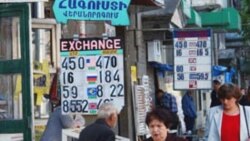By Atom Markarian
The Armenian authorities expect a further appreciation of the national currency, the dram, amid persisting concerns of local export-oriented firms that seem to have been hit hard by the nearly two-year exchange rate fluctuation.The dram has gained almost 30 percent in value against the U.S. dollar since the beginning of 2004 and is currently trading at about 455 per dollar. Its strengthening against the European Union euro has been almost as dramatic. The trend is set to continue in the coming months, with the Central Bank of Armenia (CBA) forecasting that one dollar will be worth an average of 420 drams next year.
The projection is spreading jitters among the country’s leading exporters already reeling from the loss of revenues in foreign markets. Some of them, notably agribusiness companies, are bracing for more losses.
“The exchange rate fluctuations are dealing a serious blow to our businesses,” said Seyran Poghosian, chairman of the Cigaronne cigarette maker. “There is no need to prove this.”
Eduard Ghazarian, the chief executive of the Euroterm food-processing firm, also cited substantial losses incurred as a result of the stronger dram. The Yerevan-based company manufacturing natural juices and canned food is now not only struggling to maintain its exports but also facing stronger competition in the domestic market.
“Because of the change in the dram’s exchange rate, imports have become much more beneficial and profitable,” complained Ghazarian. “That is why we and other local juice manufacturers have only a 20 percent share in the Armenian market. And yet we could have had a 100 percent share.”
“That our revenues will drop further is out of question,” he said. “The dram’s further strengthening will have a terrible impact on our exports, especially given the fact that we are using local raw materials.”
“The change in the dram’s exchange rate is whittling away our export profits,” said Aghasi Baghdasarian of the Ginetun wine company. “I think we have already lost 60 or 70 percent of our profits as a result.”
The CBA and the Armenian government insist that the dram’s strengthening has been prompted by objective factors such as a sharp rise in multimillion-dollar cash remittances sent home by hundreds of thousands of Armenians working abroad. They say the dram will continue to gain ground next year due to a further growth of the cash transfers as well as anticipated additional assistance from the U.S. government and Armenian-American billionaire Kirk Kerkorian.
However, government critics claim that the authorities themselves engineered the exchange rate fluctuation with the aim of enriching Armenia’s leading commodity importers close to the ruling regime. Both the CBA and the government have strongly denied this theory.
Some of the exporters claimed to have raised the issue with Robert Kocharian when he visited an annual exhibition of Armenia’s food processing industry late last week. However, the authorities are unlikely to deliberately weaken the national currency. The CBA has repeatedly stated that its main task is to ensure low inflation that the strong dram serves that purpose. The bank’s exchange rate policy has been endorsed by the International Monetary Fund and the World Bank.




